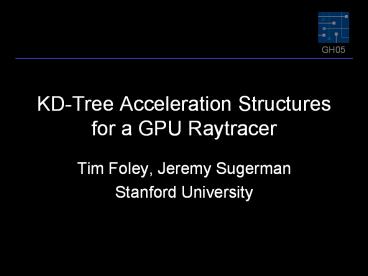KD-Tree Acceleration Structures for a GPU Raytracer PowerPoint PPT Presentation
Title: KD-Tree Acceleration Structures for a GPU Raytracer
1
KD-Tree Acceleration Structures for a GPU
Raytracer
- Tim Foley, Jeremy Sugerman
- Stanford University
2
Motivation
- Accelerated raytracing
- On commodity HW
- Production rendering
- Real-time applications?
- Performance trend
- 9800 XT 170M ray-triangle intersects/s
- X800 XT PE 350M ray-triangle intersects/s
3
GPU Raytracing
- Promising early results
- Simple scenes
- Uniform grid
- Problems with complex scenes
- Hierarchical accelerator (kd-tree)
- Improve scalability
4
Outline
- Background
- GPU Raytracing
- KD-Tree Algorithm
- KD-Restart, KD-Backtrack
- Results
- Future Work
5
Background
- RayEngine Carr et al. 2002
- Parallel ray-triangle intersection
- Host controls culling
- Purcell et al. 2002
- Entire raytracing pipeline
- Many rays required for efficiency
- Uniform Grid
6
Why not KD-Tree?
- Uniform grid acceleration structure
- Regular structure efficient traversal
- Regular structure poor partitioning
- KD-Trees
- Adapt to scene complexity
- Compact storage, efficient traversal
- Best for CPU raytracing Havran 2000
7
KD-Tree
tmin
Z
X
B
Y
D
C
A
tmax
8
KD-Tree Traversal
9
Per-Fragment Stacks
- Parallel (per-ray) push
- No indexed write in fragment program
- Per-ray stack storage
- Ernst et al. 2004
- Emulate push with extra passes
- Impractical, slow
10
Our Contribution
- Stackless kd-tree traversal algorithms
- KD-Restart
- KD-Backtrack
11
Observation
Current leafs tmax
Next leafs tmin
12
KD-Restart
- Standard traversal
- Omit stack operations
- Proceed to 1st leaf
- If no intersection
- Advance (tmin,tmax)
- Restart from root
- Proceed to next leaf
13
KD-Restart
- Restart traversal after each leaf
- m leaves
- Average depth d
- Cost O(md)
- Balanced tree of n nodes
- Upper bound O(n log(n))
- Standard algorithm O(n)
- Expected O( log(n) )
14
Observation
Ancestor of A is parent of Z
15
KD-Backtrack
- If no intersection
- Advance (tmin, tmax)
- Start backtracking
- If node intersects (tmin, tmax)
- Resume traversal
- Proceed to next leaf
16
KD-Backtrack
- Backtrack after leaf
- Revisits previous nodes
- At most twice from left, right
- Within constant factor of standard traversal
- Upper bound O(n)
- Expected O( log(n) )
- Requires additional storage
- Parent pointers
- Bounding boxes for internal nodes
17
Implementation
- Built GPU raytracer in Brook Buck et al.
- 4 intersection schemes
- Brute Force
- Uniform Grid
- KD-Restart
- KD-Backtrack
18
Scenes
Stanford Bunny 69451 triangles
Cornell Box 32 triangles
BART Robots 71708 triangles
BART Kitchen 110561 triangles
19
Results
Box
Bunny
Robots
Kitchen
12.9
Relative speedup over brute-force intersection.
20
Results
Ideal Restart Backtrack
Traverse 10.86M 21.80M 10.86M
Backtrack 0 0 7.78M
Intersect 5.91M 5.91M 5.91M
Rays in each state throughout traversal.
21
Discussion
- Absolute performance
- Trails best CPU implementations 5-6x
- Sources of inefficiency
- Load balancing
- Data reuse
22
Load Balancing
- Subset of rays intersecting, traversing
- Occlusion queries to select kernel
- Early-Z to cull inactive rays
- Approximately 5x overhead
- Query, kernel switch overhead
- Worse with fewer rays
23
Data Reuse
- Every kernel
- Loads ray origin/direction
- Load/Store traversal state
- Consumes streaming bandwidth
- We are bandwidth-limited
- CPU implementation stores these in registers
24
Branching
- Merge multiple passes into larger kernel
- Fragment branches for load balancing
- Avoid load/store of reused data
- Current branching has high overhead
- Shifts efficiency burden to HW
25
Conclusion
- Stackless Traversal
- Allows efficient GPU kd-tree
- Scales to larger, more complex scenes
- Future Work
- Changes in HW
- Alternative acceleration structures
- Out-of-core scenes
- Dynamic scenes
26
Acknowledgements
- Tim Purcell (NVIDA)
- Streaming raytracer
- Mark Segal (ATI)
- Demo machine
- NVIDIA, ATI HW
- DARPA, Rambus Funding
27
Questions

